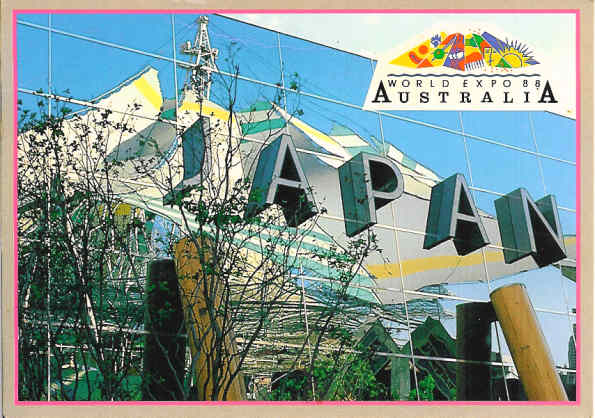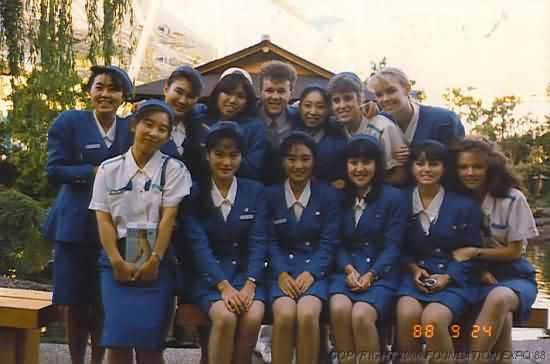National Day : July 8, 1988
Agreement to participate : 10 January 1986
Commissioner-General - Mr Tadashi Masui
Pavilion : 2176 square metres

 The Japanese representation can
be said to be, without fear or favour, one of the
best representations by a national or corporate
presence at World Expo '88.
The Japanese representation can
be said to be, without fear or favour, one of the
best representations by a national or corporate
presence at World Expo '88. It consisted of the $AUD26m Japanese Government Pavilion - the most expensive at the fair; a corporate presence by Fujitsu - which had it's own pavilion nearby; and, an Japan External Trade Organisation (JETRO)-led consortium of governments from Saitama Prefecture and Kobe-City (the respective sister-state of Queensland and sister-city of Brisbane) and Japanese corporations Hitachi, Idemitsu, and the Japan Leisure Centre. The JETRO-led pavilion was located just next to the Japanese Government pavilion, and was called the "Japan Technoplaza".
The Japanese Government Pavilion was located at the
back centre of the Expo site, facing towards
the Brisbane River and near the popular man-made 'Pacific Lagoon'
and countries of the Pacific. The Pavilion
representation had three distinct elements, (i) the Pavilion
itself (2,843 square metres), (ii) the Japanese
Garden, at the front Entrance/Exit of the Pavilion
(1,236 square metres) and (iii) a Japanese traditional leisure
boat, 17 metres in length and known as the
'Yakata-bune' <屋形
船>, that was specifically designed for
entertaining Japan Pavilion (up to 30 at a time) VIPs
on the Brisbane River during the nightly fireworks.
The Expo sun-sails are reflected stunningly in the
angled mirror roof fašade of the Japanese
Government Pavilion
Postcard
Image Courtesy and ę Papermoon
The firm responsible for the overall theme and design of the Pavilion was the <日 本科学技術振興財団> 'NipponKagakuGijutsuShink˘Zaidan' (literally the Japan Foundation for the Promotion of Science & Technology), Tokyo, with several subsidiaries responsible for the individual architectural and design elements.
The firm responsible for the overall theme and design of the Pavilion was the <日 本科学技術振興財団> 'NipponKagakuGijutsuShink˘Zaidan' (literally the Japan Foundation for the Promotion of Science & Technology), Tokyo, with several subsidiaries responsible for the individual architectural and design elements.
The Pavilion theme was "Harmony
of Tradition and Technology" - which married closely
with the Expo overall-theme of 'Leisure in the Age
of Technology'. This was cleverly
developed in the Pavilion exterior and interior -
where Pavilion visitors could experience leisure
time in traditional Japan by visiting the open-air
traditional Japanese Garden - encircled and
adjoining the front entrances and exits of the
Pavilion itself - or learn about the
contemporary application of technology to Japanese
leisure time on the inside of the Pavilion - through
a series of dance/theatre, static, interactive, and
audio-visual displays.
A unique juxtaposition of traditional Japanese Garden design and Australian native plants and shrubs, the Japanese Garden was a much cherished place of rest at the Exposition - where guests could sit and relax without encumbring lines - listen to traditional Japanese music - either as background music - or as a live performance of Japanese Harp (koto) on the Garden Pond Pagoda (where traditional Japanese dance was also peformed) - or watch - and take part in lessons in - Japanese calligraphy, flower arrangement (Ikebana), or Tea Ceremony. A gently cascading rock waterfall and pebble-stone path featured on the right side of the Garden, where boulders and rocks in seemingly ad hoc yet arranged beauty took their pride of place. The Garden entrance Gate - where a Pavilion attendant was always on duty to welcome - was dedicated by Japanese Prime-Minister Noboru Takeshita - whose calligraphy <遊翠園>'Yuu-sui-en' - 'place of quiet and green' - graced the top arch of the Gate itself.
A unique juxtaposition of traditional Japanese Garden design and Australian native plants and shrubs, the Japanese Garden was a much cherished place of rest at the Exposition - where guests could sit and relax without encumbring lines - listen to traditional Japanese music - either as background music - or as a live performance of Japanese Harp (koto) on the Garden Pond Pagoda (where traditional Japanese dance was also peformed) - or watch - and take part in lessons in - Japanese calligraphy, flower arrangement (Ikebana), or Tea Ceremony. A gently cascading rock waterfall and pebble-stone path featured on the right side of the Garden, where boulders and rocks in seemingly ad hoc yet arranged beauty took their pride of place. The Garden entrance Gate - where a Pavilion attendant was always on duty to welcome - was dedicated by Japanese Prime-Minister Noboru Takeshita - whose calligraphy <遊翠園>'Yuu-sui-en' - 'place of quiet and green' - graced the top arch of the Gate itself.
The pond and garden were reflected
beautifully in an enormous angled mirror spanning
the length of the pavilion suspended above the entrance and
exit, with the words "Nihon" <日本> (Japan) in
kanji (chinese characters) and "JAPAN" in English emblazoned in
silver, heralding the pavilion to those from afar.
The pavilion entrance, to the left, was done in white tiles, with
pebbles to either side, with low-level glass
revealing the garden, and featured a reception area
and desk where questions could be
asked, and where pavilion attendants could be seen
welcoming guests to the pavilion with the obligatory
pavilion pamphlet.
The main entrance foyer led one down
a straight corridor to the first exhibit - the
'Shishimai Robots' ('shishi' meaning 'lion', and
'mai' meaning 'dance'), where two former car-manufacturing
industrial robots dressed-up in traditional Japanese
lion dance garb, (replete with meticulously-designed lion
head-pieces in navy and red with a gold finish and
'snapping' jaws), would, in time with three stirring traditional lion
dance Japanese drum and lute refrains intricately
dance, move, and lunge at one another - much to the surprise of the
viewing audience! We often had to tease people not
to stand 'too close', and there was, for good
measure (but never used) an 'emergency button' so
that we could stop the machines for any purpose.
After the 'Shishimai' there was a
corridor to the left, which brought one to the
imaginatively designed display "Traditional Leisure
in Edo Era, 18C.", where clever use of inverted
hidden TV screens reflecting an animated image onto
a false glass screen introduced guests to the antics of
3-cm high "Hachi", a resident of 18th century Tokyo
- then known as Edo - as he 'walked' and 'talked' his way (in a
jocular Australian accent!) through the
skillfully-made village 1/15 replica scale models of Edo at the time -
complete with a rising Mt Fuji in the background.
Turning around on the
right-hand side there was a static display, entitled "Traditional
Playing Today", which thematically explored
traditional forms of Japanese leisure and festival
that are still common
today - and, as such, contained models of costumes
of Sumo-referees and Kabuki actors, as well as a portable
Shinto-shrine and traditional Japanese kites.

Next

"C" Team from the
Japan Pavilion, in the Japanese Garden, World
Expo '88
(That's me - in the
middle!)Next